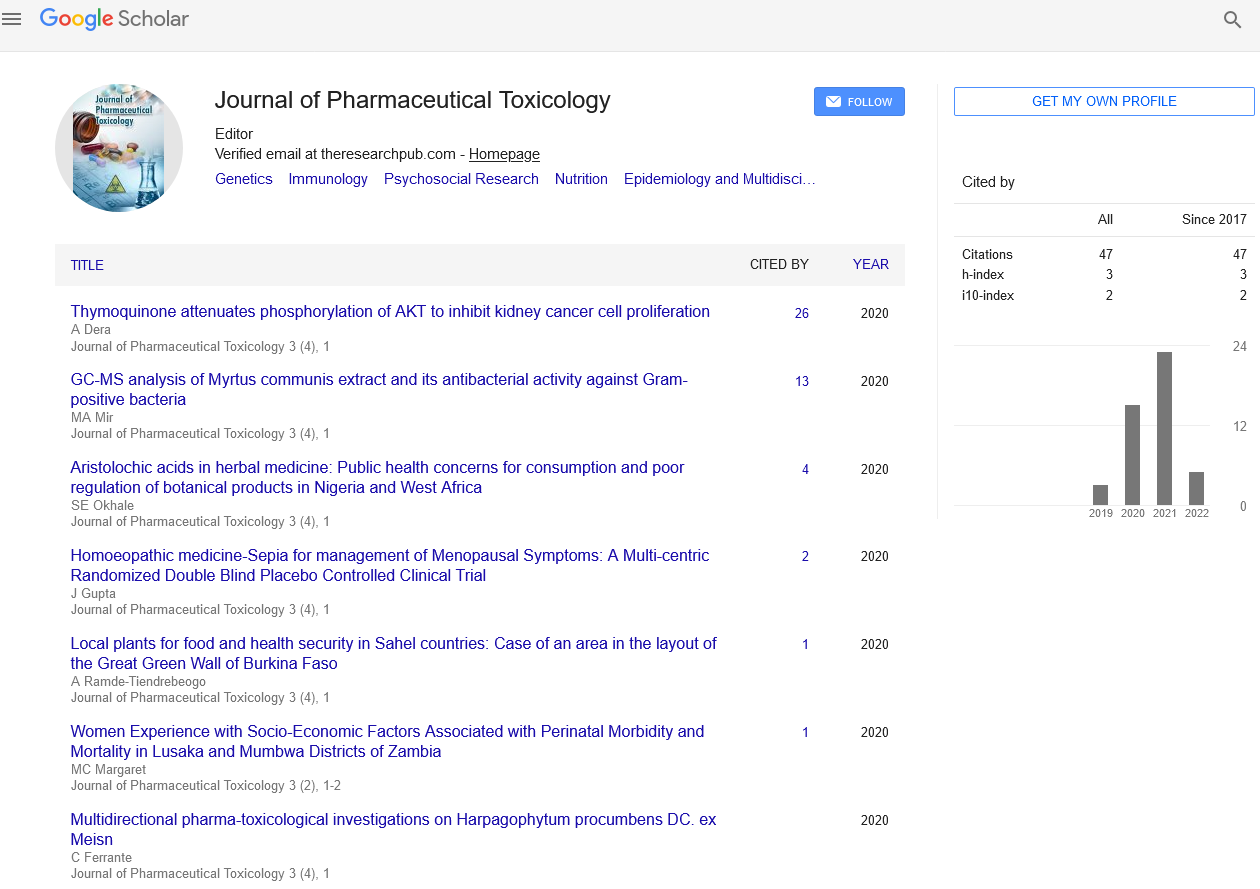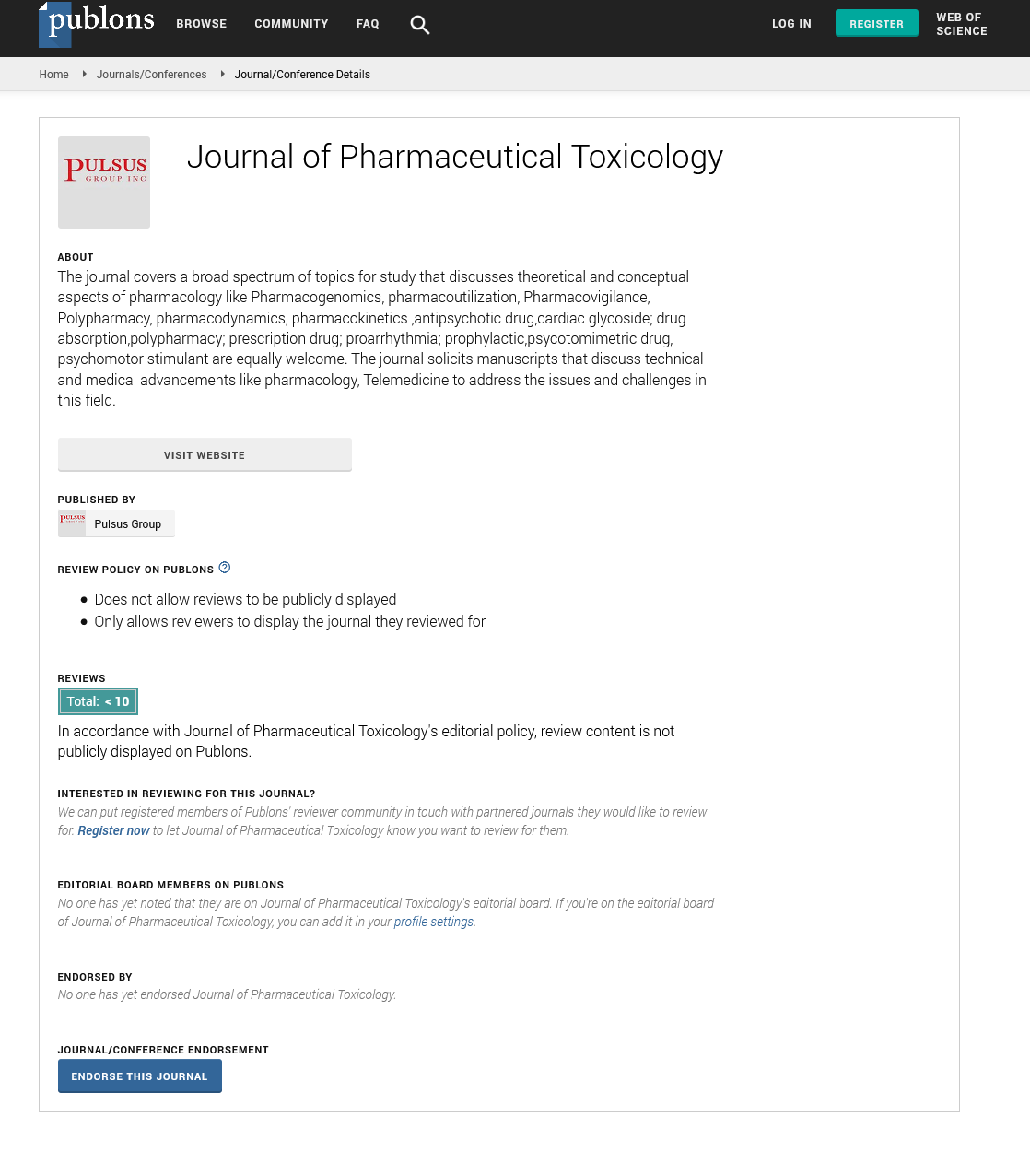Mini Review - Journal of Pharmaceutical Toxicology (2023) Volume 6, Issue 1
Evaluation of Greenness Profile Using Spectrophotometric and Multivariate Calibration Methods for Simultaneous Drug Identification in Pharmaceutical Formulations and Human Urine
Yaser Pashaei*
Young Researchers and Elite Club, Tehran Medical Sciences, Islamic Azad University, Tehran, Iran
Young Researchers and Elite Club, Tehran Medical Sciences, Islamic Azad University, Tehran, Iran
E-mail: yaser.pashaei@yahoo.com
Received: 01-Feb-2023, Manuscript No. jpt-23-88854; Editor assigned: 04-Feb-2023, PreQC No. jpt-23- 88854(PQ); Reviewed: 18-Feb-2023, QC No. jpt-23-88854; Revised: 25- Feb-2023, Manuscript No. jpt-23- 88854(R); Published: 28-Feb-2023, DOI: 10.37532/jpt.2023.6(1).01-04
Abstract
For the determination of atenolol, paracetamol, hydrochlorothiazide, and levofloxacin, two spectrophotometric techniques that are quick, affordable, and environmentally friendly were created. The newly created extended derivative ratio (EDR) is the first approach, and multivariate curve resolution-alternating least squares are the second approach (MCRALS). Atenolol, paracetamol, hydrochlorothiazide, and levofloxacin were each quantified using the extended derivative ratio amplitudes at 281.6, 237.6, 279.2, and 282.8 nm in the EDR method. Correlation constraint was used and a calibration model was created for the MCR-ALS approach. Seven mixtures from an external validation data set were employed, and various figures of merit including bias, standard error of prediction, and relative error of prediction were determined. The results were satisfactory. These two methods resulted in the use of an external validation data set made up of seven mixtures allowed for the calculation of various figures of merit, including bias, root mean square error of prediction, standard error of prediction, and relative error of prediction, with satisfactory results. Results from both techniques were comparable. The techniques were tested and used to identify the target analytes in dosage forms, spiked urine, and actual human urine. Following that, the obtained findings were statistically compared to the published methods, but no discernible difference was found in terms of accuracy or precision. Analytical Eco-Scale and the National Environmental Methodologies Index (NEMI) were also used to assess the greenness profile of the methods for the routine examination of the investigated medicines in dosage forms and human urine, the established methods can be utilised as a reliable, easy, and cost-effective substitute for the widely used chromatographic methods.
Keywords
pharmaceutical analysis • drug determination • biological investigations • toxicity and reviews • chromatographic methods • spectrophotometric
Introduction
Atenolol (AT), a selective ß1 receptor blocker, is used to treat coronary heart disease and hypertension. Over 85% of the absorbed medication is eliminated in the urine as an unaltered substance, and AT experiences little to no liver metabolism. Numerous analytical methods, including high performance liquid chromatography (HPLC), spectrophotometric, capillary electrophoresis, gas chromatography (GC), and spectro fluorimetric approaches, have been published for the measurement of AT. Acetaminophen, sometimes known as paracetamol (PR), is an over-the-counter (OTC) analgesic and antipyretic medication. PR is mostly eliminated in urine after being metabolised in the liver. One to four percent of the dosage given is excreted unaltered. However, 25–36% of the dosage is excreted as glucuronide-conjugated paracetamol and 47–62% as glucuronide–paracetamol conjugates. A tiny portion (8–10%) is metabolised by oxidation to create conjugates of cysteine and mercapturic acid [1].
There are numerous studies for the analysis of PR in the literature, including HPLC, GC, spectrophotometry, voltammetry, and electrophoresis. The thiazide diuretic hydrochlorothiazide (HZ) is used to treat edoema and hypertension that are brought on by disorders including congestive heart failure. Over 95% of HZ is eliminated in urine as an unaltered medication. For HZ quantification, many methods including spectrophotometry, voltammetry, GC, HPLC, and spectrofluorimetry have been published [2]. In Gram-positive and Gramnegative bacteria, DND topoisomerase IV and gyrase are respectively inhibited by the fluoroquinolone antibiotic levofloxacin (LV). It treats infections of the skin, soft tissues, lungs, and urinary system. The literature contains numerous publications on the measurement of LV using various methods, including capillary electrophoresis, voltammetry, spectrophotometry, and HPLC. Some people may be able to take AT, PR, HZ, and LV concurrently. These medications are primarily eliminated in the urine. To the best of our knowledge, no method for simultaneously determining the four medicines has been published [3].
Analytical chemists are very interested in green analytical chemistry (GAC), which focuses on creating sustainable and ecologically friendly new methods. However, the difficulty is to strike a balance between raising the created methods’ quality and enhancing their greenness. When compared to HPLC, UV-Vis spectroscopy is regarded as a more environmentally friendly analytical method. UV-Vis spectroscopy is a quick method that uses small amounts of solvent, lowering the amount of waste produced. This method also saves money because it doesn’t require pricy chemicals or pricey equipment. However, the study of multicomponent mixtures presents a significant barrier when utilising UV-Vis spectroscopy, particularly when the analysis spectra are significantly overlapping. The author suggested using an unconventional spectrophotometric technique, called extended derivative ratio, to address this issue (EDR). Additionally, the multicomponent mixture was mathematically resolved with the aid of multivariate calibration [4].
Therefore, the goal of this work was to create accurate, economical, and environmentally friendly methodologies for the analysis of AT, PR, HZ, and LV. Extended derivative ratio (EDR), a non-traditional univariate method, and multivariate curve resolution-alternating least squares (MCR-ALS), a multivariate method, were created, validated, and then successfully used for the four analyses. The analytical Eco-Scale and the National Environmental Methods Index (NEMI) were also used to evaluate the method’s greenness [5].
Materials and Methods
Over the whole wavelength range (200- 330 nm), the four analyses’ absorption bands severely overlap. Therefore, utilising standard calibration procedures without prior separation to determine these medications simultaneously is difficult. As a result, non-traditional univariate and multivariate spectrophotometric approaches that are straightforward, accurate, and trustworthy were proposed for the simultaneous detection of AT, PR, HZ, and LV in pharmaceutical dosage forms, spiked urine samples, and genuine human urine samples. The effectiveness of the created procedures was also assessed and statistically compared with approaches that had already been published [6].
The significant spectrum overlap between the target analytes shows how well the suggested technique resolves these conflicts. A divisor mixture made up of the other three analytes can be used to identify each analyte. Six synthetic mixes with various ratios of AT, PR, HZ, and LV within their linear ranges were created. These solutions’ zero-order absorption spectra were captured and saved. The stored AT divisor was used to divide the stored spectra of standard solutions containing AT, PR, HZ, and LV, and the second derivative of the resulting ratio spectra (2DD) was calculated using = 4 nm and scaling factor 10. This procedure was used to determine AT. Reproducible amplitude was chosen from the resulting derivative spectra for AT determination, At 281.6 nm, the predicted amplitude [7].
The existence of unknown sample interferences in the urine matrix and the extreme spectrum overlap between the four analytes make the employment of multivariate calibration models necessary to resolve these types of combinations. Only if the interfering background is adequately captured during the calibration phase will first-order multivariate calibration approaches make sense in this situation. However, first-order approaches might not be the best option if such interferences are not taken into account during the calibration. Second-order multivariate calibration models may perform better in these circumstances due to their strong capacity to predict outcomes even in the presence of unidentified interferences. Without analysing urine, the MCR-ALS model was created in this study to identify the four analytes of interest in pharmaceutical dosage forms and spiked human urine samples [8].
While creating the MCR-ALS model, the calibration matrix underwent no data preprocessing. Initial estimation of the target analytes’ pure spectra was carried out in order to achieve a respectable resolution by the MCR-ALS model. It was discovered that five factors were in charge of the variances between the samples. The model was created using correlation constraints and the no negativity constraint (for spectral and concentration profiles). 5 species were resolved by the model [9]. The first four curves closely resembled the AT, PR, HZ, and LV spectra, with correlation coefficients between the real and calculated AT, PR, HZ, and LV spectra being (0.9996, 0.9998, 0.9997, and 09999, respectively). The interfering urine matrix was predicted to be the sixth spectrum. Finding the concentration profiles of each analyte using the resolved matrix for each analyte produced good results with a low lack of fit (% lof ) of 0.1721. The created model successfully explained 99.99% of the variance in the examined spectra. The model’s predictive power was demonstrated by determination coefficients for each of the four analytes that were at least 0.9998 [10].
Conclusion
For the analysis of AT, PR, HZ, and LV in various pharmaceutical dosage forms, quick, accurate, and economical green nonconventional univariate and multivariate chemo metricsassisted spectrophotometric approaches were devised. The four analytes were successfully determined using the suggested methods in both spiked and authentic human urine samples, and the results from each approach were comparable. The evaluation of the two methodologies’ greenness profiles revealed that they constitute an excellent green analysis of the medications under study with very little adverse environmental consequences. Furthermore, neither sample preparation nor specialised HPLC equipment or pricey solvents are required for the proposed procedures. The EDR approach also has the benefit of being straightforward and not requiring the intricate mathematical procedures required for the MCR method. However, choosing the best divisor to obtain precise and repeatable results has proven to be the most difficult part of designing the EDR approach. Compared to other first-order multivariate calibration methods, the MCRALS method has the benefit of being able to provide accurate predictions even when there are inferences that are not taken into account throughout the calibration process. For the routine examination of the investigated medicines in dosage forms and human urine, the proposed methods can be employed as a reliable, eco-friendly, straightforward, and cost-effective substitute for the widely used chromatographic methods.
Conflict of Interest
None
Acknowledgement
None
References
- Forrest JAH, Clements JA, Clements JA et al. Clinical pharmacokinetics of paracetamol. Clin Pharmacokinet. 7:93-107 (1982).
- Parojčić J, Karljiković‐Rajić K, Durić Z et al. Development of the second‐order derivative UV spectrophotometric method for direct determination of paracetamol in urine intended for biopharmaceutical characterisation of drug products. Biopharm Drug Dispos. 24. 309-314 (2003).
- Wart SA, Shoaf SE, Mallikaarjun S et al. Population‐based meta‐analysis of hydrochlorothiazide pharmacokinetics. Biopharm Drug Dispos. 34:527-539 (2013).
- Hasannejad H, Takeda M, Taki K et al. Interactions of human organic anion transporters with diuretics. J Pharmacol Pharmacother. 308:1021-1029 (2004).
- Mohammed FF, Badr El-Din K, Derayea SM et al. Two smart spectrophotometric methods for simultaneous determination of Lisinopril and Hydrochlorothiazide in binary mixtures. Adv Biomed Res. 2:47-53 (2019).
- Keith L, Gron L, Young J et al. Green analytical methodologies. Chem Rev. 107:2695-2708 (2007).
- Windig W, Guilment J. Interactive self-modelling mixture analysis. Anal Chem. 63:1425-1432 (1991).
- Juan A, Tauler R. Chemo metrics applied to unravel multicomponent processes and mixtures: revisiting latest trends in multivariate resolution. Anal Chem Acta. 500:195-210 (2003).
- Castagna A, Cecconi D, Sennels L et al. Exploring the hidden human urinary proteome via ligand library beads. J Proteome Res. 4:1917-1930 (2005).
- Levi F, Ferlay J, Galeone C et al. The changing pattern of kidney cancer incidence and mortality in Europe. BJU International. 101:949-958 (2008).
Google Scholar, Crossref, Indexed at
Google Scholar, Crossref, Indexed at
Google Scholar, Crossref, Indexed at
Google Scholar, Crossref, Indexed at
Google Scholar, Crossref, Indexed at
Google Scholar, Crossref, Indexed at


